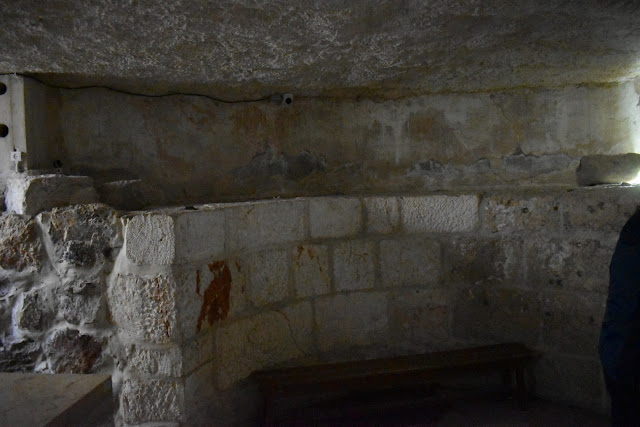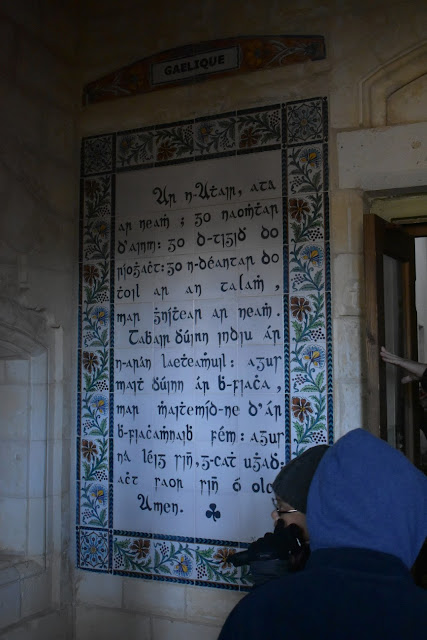We would begin Day 9 with a ride up to the top of the Mount of Olives. Unlike the past few days, this day didn't start super early.
Those of us interested in praying for an hour in the Church of the Holy Sepulchre could do so. My first entry in my trip's journal mentions going there in the first sentence. The second sentence records the moment that I am glad I wrote down--it marked the moment I didn't understand at the time in the Church of the Holy Sepulchre, but I would spend the many months following the trip gaining more insights into it week by week. It will lead to my next project, which I alluded to previously, and continues to intrigue me more than anything else in the trip. So February 11th marks the date that would spark the interest, and a day in the latter part of March would finally make sense of what I wasn't grasping at the time. Until that project makes good progress, I don't plan to share much more in a very public way.
On with this day...
This is the day we intend to walk the Palm Sunday Path down the mount. The only day after this is a day that's intended to be a mostly free day to do as we wish before heading back. So this is the day they packed quite a few places into the schedule. The Church of Pater Noster is near the top of the Mount of Olives. If Latin is Greek to you, "Pater Noster" means "Our Father". This is a site where Jesus taught the Apostles many things. Some people believe the Our Father was taught here. The Gospels also identify a story where it was taught in Galilee.
With this site being so near the top of the mount, this is also a site where the Ascension of Jesus is said may have occurred. It is in this general area at the very least. A site that associates itself with that incident is the Ascension Chapel, that is within a block from this site. We did not go there. Although that site could be the site of the ascension, the claim that the footprints of Jesus are embedded into the stone at the last point where he made contact with the ground seems more like mythical legend to me. The account of the ascension didn't make it sound like he leapt into the air, thus having such force as to leave an indentation for each of his feet in the stone. If Jesus rose up, then why would his feet leave such indentations in the rock? It's a nice story, but it doesn't make sense to me. It's easier for me to believe that seeing those indentations could give people reason to create a legend that the incident happened at that site, whether it happened there, here, or somewhere else near the top of this mount.
 |
| Church of Pater Noster |
The main feature of this church is the way it posts the text of the Our Father in many languages. There were at least 176 languages when we visited, and they keep adding more with time. I even saw a tourist site recently claim it was 140+ languages. So you can tell that since they made that entry, roughly 30 more were probably added by the time we visited the church.
Here is the entryway to the church property.
It also goes by the name "Eleona". That's a Greek name for "Olive Grove", which makes sense for the Mount of Olives.I wasn't quite sure what the layout would be, and found this view rather interesting compared to most other views. It shows some of the many translations, but some architecture and passageways. One even sees more panels with the Our Father through the doorway. And...some guy seems to be looking out the door on the left. I'm not sure if he was just peering out or if I caught him mid-stride walking out.
Here's a map of the place, also on the wall.
This next photo is the other main photo that does an even better job of showing many of the things on the site. Had I used this for the featured photo up front, people might just think the church is at the top part here and they might ignore the foreground. But the foreground is important.
Here is the courtyard. The various languages of the Our Father is almost like a wallpaper for the walls, except it's not paper. I mean that in terms of it being this recurring pattern, but with a different language for each panel.
We were told English was in the church. That makes some sense, because it's such a common language. But at the same time, the languages placed outside allow many more people to see them easily. There isn't a major traffic flow issue for people going in and out of an open-air space. The next few photos allow me to show off the space from right to left, continuing from the right-most panning above.
This is another French property, and thus a French flag.
When I stood in front of the steps and faced the church, I was able to see into the area under the columns a bit better.
Looking out from this site...
If you want to know what the Our Father looks like when written in Hebrew or Aramaic, two languages Jesus knew and spoke, there's a special panel for that. It looks nothing like the others.
So let's go down into the grotto, following our tour guide. Speaking of our guide, the trip started out with two guides, one per bus. But enough people took an option for the trip that would split the group and reduce our needs to just one bus. At that time, we ended up with the other tour guide. This is Usama, who is very highly respected and is a great tour guide. It was because he was so good that the other bus had him as their guide for the earlier part of the trip, since they took some priority. I'm glad we had a chance to have him as our guide for the latter part of the trip.
Here is the entry to the grotto as I'm about to head down and into it.
This is the interior of the grotto.
This is the way back out from the inside.
But there are plenty more people from our group still entering.
This ledge stood out to me. I don't believe anything was said about it. I could be wrong. But I tend to notice the things that are either very significant or very modern additions. I either notice what doesn't quite fit in because it's a later addition, or because it's one of the reasons for what is there. This was an abnormally large, flat surface compared to the rest of the grotto. That's what makes it stand out. It's smoothed more than most rocks here along the top and edges. But I could easily imagine people running their hands along it, if not possibly sitting on it. That could easily explain the smoothness.
Now for some language lessons!
If you took offense at that, then perhaps I'm not going to offer any good Samaritain.
Anyone with Irish heritage might appreciate Gaelic.
I made it into the church. This is the main altar. This church seems to have paid all attention on the prayers and very little on decor. I suppose they don't have luxuries, but have given this day enough for their daily needs.
For my Vietnamese friends, I assume this is what you pray when you pray the Our Father. I sometimes hear it among the other prayers sung by some Vietnamese people who pray the final shift of Eucharistic Adoration on Fridays at St. Patrick's Church in Cedar Rapids. I love hearing them pray.
I look up to Jesus.
Ah...English...Braille...cool. I am VERY glad they used metal so the bumps would remain better. It's very touching that they include this for the people who cannot see or even those who understand it. Yes, another pun was intended there--very touching.
This one is just Anglais...wait, that's English! I've found it! I will point out that there are some languages that are so similar to each other that one has to pay very close attention. The language may not be written in your own native language (I think it should be). It's like when we refer to Deutschland as Germany, or Roma as Rome. Why must people have slight variations?
After stepping out, it's time for a bit of a view of the city from the top of this place on the top of the Mount of Olives.
I assume I still used my smaller lens for this shot.
But it's time to switch lenses. Yes, this is much better. It's naturally vivid, and the resolution and sharpness is much better than if I had used my phone or any other digital camera I may have.
We will start walking down the mount from here.
































Comments
Post a Comment